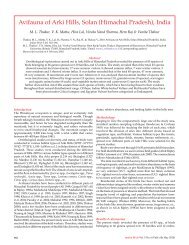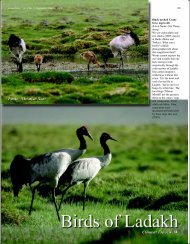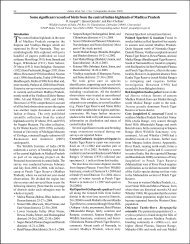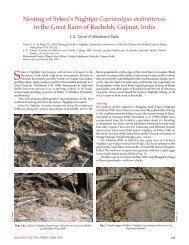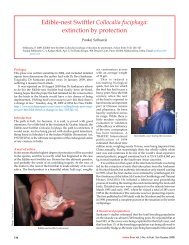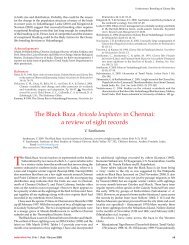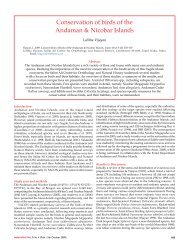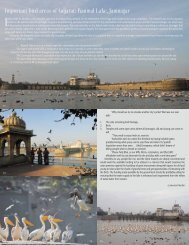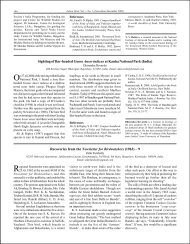The raptors and the agamid - Indian Birds
The raptors and the agamid - Indian Birds
The raptors and the agamid - Indian Birds
You also want an ePaper? Increase the reach of your titles
YUMPU automatically turns print PDFs into web optimized ePapers that Google loves.
<strong>The</strong> <strong>raptors</strong> <strong>and</strong> <strong>the</strong> <strong>agamid</strong>Ashwin BaindurBaindur, A. 2009. <strong>The</strong> <strong>raptors</strong> <strong>and</strong> <strong>the</strong> <strong>agamid</strong>. <strong>Indian</strong> <strong>Birds</strong>. 5 (1): 11–13.Col Ashwin Baindur, OIC Corps Archive & Museum, CME, Dapodi Pune 411031, Maharashtra, India. Email: ashwin_baindur@yahoo.comMss received on 12th December 2008.Aposting to <strong>the</strong> desert for an army-man is not unusual <strong>and</strong>I got my chance to serve in this terrain in mid 2004, atJaipur, after more than 20 years of service; on all previousoccasions as a junior officer, I had passed through fleetinglywith hardly a chance to notice or experience anything. Now aComm<strong>and</strong>ing Officer, I eagerly anticipated getting a good lookat <strong>the</strong> l<strong>and</strong>scape <strong>and</strong> its wildlife.At <strong>the</strong> first opportunity I w<strong>and</strong>ered off into <strong>the</strong> desert in aGypsy 4WD. Driving eastward along <strong>the</strong> NH from Jaisalmertowards Jodhpur, I saw an obscure desert track <strong>and</strong> turned ontoit, speeding on <strong>the</strong> s<strong>and</strong>y track across <strong>the</strong> country, towards <strong>the</strong>beckoning dunes. On each side were wide-open spaces punctuatedby <strong>the</strong> occasional khejri tree Prosopis cinerarea. A cross-breeze trickleds<strong>and</strong> across <strong>the</strong> track <strong>and</strong> shadows grew long as <strong>the</strong> sun pausedover dunes. A small desert fox Vulpes vulpes pusilla with a bushy,white-tipped tail (Menon 2003) ran away from <strong>the</strong> vehicle.All of a sudden, a large lizard zipped across <strong>the</strong> road, a fewmetres ahead of me, <strong>and</strong> dived into <strong>the</strong> s<strong>and</strong>. Before I could apply<strong>the</strong> brakes, <strong>the</strong> lizard was gone. I could not register what exactlyhad happened, even though it happened again <strong>and</strong> yet again.Lizards zoomed past, left <strong>and</strong> right. I was driving across a lizardcolony like a German panzer division across <strong>the</strong> Russian steppe.In <strong>the</strong> fading light, <strong>the</strong> impression that stood out fleetingly wasthat of a thick tail with black <strong>and</strong> white rings.A few days later, I ventured across <strong>the</strong> same path at midmorning.I soon came across <strong>the</strong> colony of dust-brown lizards.Stopping <strong>the</strong> vehicle <strong>and</strong> getting out scared <strong>the</strong>m away, so Iresorted to driving up as close as I could <strong>and</strong> using binoculars. Ilooked hard <strong>and</strong> long at a large, snub-headed lizard with a ringedtail. I had finally met up with Uromastyx hardwickii Gray, 1827,Hardwicke’s spiny-tailed lizard or ‘s<strong>and</strong>a’ as it is called in Hindi(Daniel 1983).<strong>The</strong>se lizards belong to <strong>the</strong> family Agamidae <strong>and</strong> are <strong>the</strong> onlyspecies of Uromastyx to be found in India—most of <strong>the</strong>ir relativesbeing North African or West Asian—with stubby legs holding aless-than-half-a-metre long cylindrical body barely off <strong>the</strong> s<strong>and</strong>,<strong>the</strong>se vegetarian <strong>agamid</strong>s hold up <strong>the</strong>ir large rounded heads, withflat snouts, smartly as <strong>the</strong>y alertly look ahead. <strong>The</strong> slightest alarmsends <strong>the</strong>m zipping off into <strong>the</strong>ir burrows in <strong>the</strong> s<strong>and</strong>. <strong>The</strong>ir mostinteresting aspect is <strong>the</strong> tail. It has blue-gray spines arranged inwhorls along its length, decreasing in size towards <strong>the</strong> tip, whichis a pale or earthy yellow in colour.Clement FrancisFig. 1. Spiny-tailed Lizard Uromastyx hardwickii.<strong>Indian</strong> <strong>Birds</strong> Vol. 5 No. 1 (Publ. 10th June 2009)11
Baindur: Raptors <strong>and</strong> <strong>the</strong> <strong>agamid</strong>Ashwin BaindurLaggar Falcon Falco jugger feeds on a Spiny-tailed LizardUromastyx hardwickii.<strong>The</strong> Uromastyx is one of <strong>the</strong> few lizards utilised by man. InNorth Africa, it is considered ‘dhaab’ or fish of <strong>the</strong> desert <strong>and</strong>relished by Islamic nomad tribes (Grzimek 2003). In India too,<strong>the</strong>se lizards are caught for <strong>the</strong>ir meat, about which Malcolm Smith(1935) says, ‘…with certain castes of Hindoos it is a regular articleof diet…<strong>the</strong> meat is said to be excellent <strong>and</strong> white like chicken…<strong>the</strong> head <strong>and</strong> feet are not eaten, but <strong>the</strong> tail is considered a greatdelicacy…<strong>the</strong> fat of <strong>the</strong> body is boiled down <strong>and</strong> <strong>the</strong> resulting oilis used as an embrocation <strong>and</strong> also as a cure for impotence.’Uromastix hardwickii repesents <strong>the</strong> sou<strong>the</strong>rn <strong>and</strong> eastern limitof <strong>the</strong> extent of <strong>the</strong> Indo-African reptile fauna (Gün<strong>the</strong>r 1864).Interestingly, <strong>the</strong> lizard is named after a fellow-soldier, MajorGeneral Thomas Hardwicke, who is considered <strong>the</strong> first colossusof <strong>Indian</strong> natural history. He arrived at Fort William in 1778 asan artillery cadet in <strong>the</strong> Bengal Presidency Army, fought in <strong>the</strong>Rohilla <strong>and</strong> Mysore wars <strong>and</strong> was commended for gallantry on<strong>the</strong> battlefield. By 1809, he rose to comm<strong>and</strong> <strong>the</strong> Bengal PresidencyArtillery. His span of duty <strong>and</strong> area of natural history study laymostly in what is today Orissa, Jharkh<strong>and</strong>, Bihar, Uttar Pradesh,Bengal, Assam <strong>and</strong> Bangladesh (Singh 2006).I visited <strong>the</strong> lizard colony often—initially, I thought <strong>the</strong>mugly but soon found that <strong>the</strong>y looked very good to my eyes. <strong>The</strong>ywere always basking in <strong>the</strong> sun. I spent a couple of hours oneday trying to observe <strong>the</strong>m feeding. I hoped to see <strong>the</strong>m nibblingon <strong>the</strong> ‘siniya’ shrubs Crotalaria burhia or tufts of ‘buadi’ Aervapseudotomentosa (?) that dotted <strong>the</strong> l<strong>and</strong>scape around <strong>the</strong>m. A fewProsopis of <strong>the</strong> native variety, whose beans <strong>the</strong>y are reported to eat(Daniel 1983), were present within a few metres of <strong>the</strong> colony. <strong>The</strong>colony itself was on a flat, firm gap between eroded s<strong>and</strong> dunes,which had been stabilised by vegetation, barely two meters high.<strong>The</strong> desert track me<strong>and</strong>ered along this flat for a 100 m or so, whichconstituted <strong>the</strong> diameter of <strong>the</strong> colony.Ashwin BaindurDebris below Tawny Eagle Aquila rapax perch: bones, old pellets <strong>and</strong> an Uromastyx tail.12 <strong>Indian</strong> <strong>Birds</strong> Vol. 5 No. 1 (Publ. 10th June 2009)
Baindur: Raptors <strong>and</strong> <strong>the</strong> <strong>agamid</strong>One day, my son <strong>and</strong> I had <strong>the</strong> rare privilege of observinga predator catching its prey. A few lizards basked outside <strong>the</strong>irburrows while <strong>the</strong> rest were inside. All at once <strong>and</strong> apparently fromnowhere, a brown raptor swooped straight down, with trailingwings <strong>and</strong> extended talons. Before <strong>the</strong> hapless lizards could gainshelter, it had caught a small agama. In <strong>the</strong> wink of an eye, <strong>the</strong> restof <strong>the</strong> lizards were out of sight. <strong>The</strong> raptor’s sharp claws soon endeda few seconds of struggle. It remained on <strong>the</strong> s<strong>and</strong> about 60 m away,feeding ravenously. It was unaware of its audience, since its backwas towards us, <strong>and</strong> I was forced to edge onto <strong>the</strong> dune <strong>and</strong> outflankit from <strong>the</strong> east. On reaching a vantage point, I had a good look at itthrough <strong>the</strong> binoculars. It fed hungrily for a good 15 min.It was a dark brown falcon, with prominent moustaches <strong>and</strong> awhite chest. Its thighs were dark-brown <strong>and</strong> it had a brown crown.Grimmett & Inskipp (2001), a book that I find h<strong>and</strong>y, despite <strong>the</strong>irpesky habit of renaming <strong>Indian</strong> birds, told me that it was a LaggarFalcon Falco jugger. I later had <strong>the</strong> identification reconfirmedthrough <strong>the</strong> kind courtesy of a member of India-nature-pix.In about 20 min, <strong>the</strong> falcon had eaten <strong>the</strong> lizard. I could hardlysee any remains. Angling to get a better view, I alerted it. After amoment or two, it flew off. I walked up to <strong>the</strong> kill, but had a hardtime locating <strong>the</strong> forlorn grey tail, which was all that remained.I visited <strong>the</strong> colony often, hoping to see more signs ofpredation. Since <strong>the</strong> local foxes are largely nocturnal, I had nothad an opportunity to observe <strong>the</strong>ir feeding behaviour. I suspectedthat <strong>the</strong>se lizards, <strong>and</strong> <strong>the</strong> many small rodents that poked <strong>the</strong>irheads out after dark, formed part of <strong>the</strong>ir diet.For a few months, nothing interesting happened duringmy field trips. <strong>The</strong>n in mid-summer, I chanced to go south ofJaisalmer. It was a windy day. <strong>The</strong> s<strong>and</strong> blew steadily, forming aconstant desert haze. I found a small colony of Uromastyx next to<strong>the</strong> road. To my surprise, this time <strong>the</strong>re was a raptor nearby. Itwas a large, brown, heavy-set Tawny Eagle Aquila rapax perchedon a desiccated ‘rohida’ tree Tecomella undulata. <strong>The</strong> lizards <strong>and</strong>eagle appeared to be oblivious of each o<strong>the</strong>r <strong>and</strong> seemingly intentonly on braving out <strong>the</strong> scouring s<strong>and</strong>storm. <strong>The</strong> swirling s<strong>and</strong>inhibited <strong>the</strong> use of binoculars so I walked up to <strong>the</strong> tree, uponwhich <strong>the</strong> raptor took off into <strong>the</strong> brown swirls. Numerous whitestreaks on <strong>the</strong> bole <strong>and</strong> branches told me that it was a favouriteperch. I sifted <strong>the</strong> litter at <strong>the</strong> base of <strong>the</strong> tree in <strong>the</strong> hope of gettingpellets but found something else—desiccated spiny-tail fragments<strong>and</strong> a few bones. This seemed to indicate that <strong>the</strong> Tawny Eaglewas a likely predator of Uromastyx.<strong>The</strong> Tawny Eagle was one of my constant objectives in <strong>the</strong>field—a strong <strong>and</strong> agile bird of prey—it was <strong>the</strong> predominantavian desert raptor. During a drive on 11th June 2006, along whatI call ‘Eagle Alley’, a 10 km stretch of road between Pokharan <strong>and</strong>Khetolai, I counted 12 Tawny Eagles perched on wires, mastersof all <strong>the</strong>y surveyed.A few days later, I returned to Eagle Alley to see a h<strong>and</strong>someTawny Eagle, a beautiful near-orange-fawn in colour, sitting ona concrete fence picket near Chacha Odhaniya railway station.It looked at me very distastefully <strong>and</strong> proceeded to express itsopinion of me by being violently sick! It <strong>the</strong>n flew off without abackward glance. I suspected that it had just ejected a pellet <strong>and</strong>scrambled across barbed wire <strong>and</strong> thorn to get at it. I was gratifiedto find a sticky yellow-white pellet with spines of Uromastyx clearlyvisible. I photographed <strong>the</strong> pellet, delicately maneuvered it into apoly<strong>the</strong>ne bag <strong>and</strong> brought it home; but alas some over zealoushouse cleaning left me with no chance to dissect it.Lydekker (1895) states about <strong>the</strong> Saker Falcon F. cherrug that,‘In <strong>the</strong> Harriana Desert of India <strong>the</strong>se falcons feed largely on aspiny lizard of <strong>the</strong> genus Uromastix.’Fig. 3. Tawny Eagle Aquila rapax.<strong>The</strong> Saker Falcon is, of course, a winter visitor to <strong>the</strong> <strong>Indian</strong>Subcontinent, while <strong>the</strong> Tawny Eagle <strong>and</strong> <strong>the</strong> Laggar Falconare residents. <strong>The</strong> Spiny-tailed lizard, being locally common inpatches, is probably a significant food source for <strong>the</strong>se birds ofprey of <strong>the</strong> <strong>Indian</strong> Desert.Soon after, my unit moved out from Rajasthan <strong>and</strong> I saw mylast Spiny-tailed lizards on a stormy July evening braving <strong>the</strong> s<strong>and</strong>sitting close to <strong>the</strong>ir shelters. Nearby somewhere, I was sure, wereTawny Eagles, girding <strong>the</strong>mselves against <strong>the</strong> gritty dust storm,which brought my tryst with <strong>the</strong> desert to an end. Our specialtrain chugged out of Lathi at nightfall <strong>and</strong> I left <strong>the</strong> desert <strong>and</strong> allits mysteries behind me yet again.AcknowledgementsN<strong>and</strong>an Kalbag for identification of plants; Dr J. Pranay Rao of RaptorConservation Foundation, Hyderabad, for confirming identities of <strong>the</strong><strong>raptors</strong> mentioned in <strong>the</strong> article; Pervez Cama, Ashok Captain <strong>and</strong> L.Shyamal for encouragement <strong>and</strong> guidance.ReferencesDaniel, J. C. 1983. <strong>The</strong> book of <strong>Indian</strong> reptiles. Mumbai: Bombay NaturalHistory Society.Grimmett, R., Inskipp, C. & Inskipp, T. 2001. Pocket guide to <strong>the</strong> birds of <strong>the</strong><strong>Indian</strong> Subcontinent. New Delhi: Oxford University Press.Grzimek, B. 2003. Grzimek’s animal life encyclopedia (second edition): Vol.7—reptiles. Farmington Hills, Minnesota: Thomson-Gale.Gün<strong>the</strong>r, A. C. L. G. 1864. <strong>The</strong> reptiles of British India. London: RobertHardwick. Electronic reprint of 2000 by Arment Biological Press.Lydekker, R. 1895. <strong>The</strong> Royal natural history. Vol 4. London: FrederickWarne.Menon, V. 2003. A field guide to <strong>Indian</strong> mammals. New Delhi: DorlingKindersley & Penguin India.Singh, Lt. Gen. Baljit (Retd). 2006. Fauna <strong>and</strong> Flora: contributions by <strong>the</strong> <strong>Indian</strong>Army officers 1778–1952. www.usiofindia.org/article_Oct_ Dec06_13.htm. (Accessed: 10th December 2008).Smith, M. A. 1935. <strong>The</strong> fauna of British India including Ceylon <strong>and</strong> Burmah,Reptilia <strong>and</strong> Amphibia: Sauria. Vol 2. London: Taylor <strong>and</strong> Francis.Wikipedia (http://en.wikipedia.org) articles on Uromastyx hardwickii,Aquila rapax <strong>and</strong> Falco jugger.Ashwin Baindur<strong>Indian</strong> <strong>Birds</strong> Vol. 5 No. 1 (Publ. 10th June 2009)13




